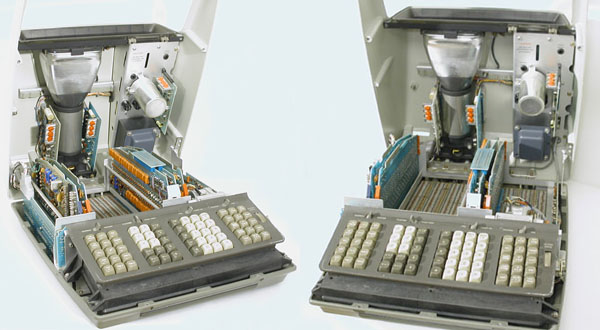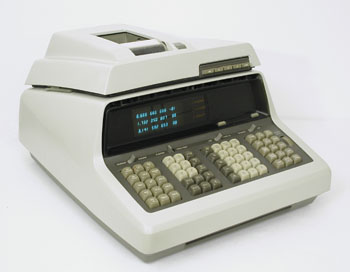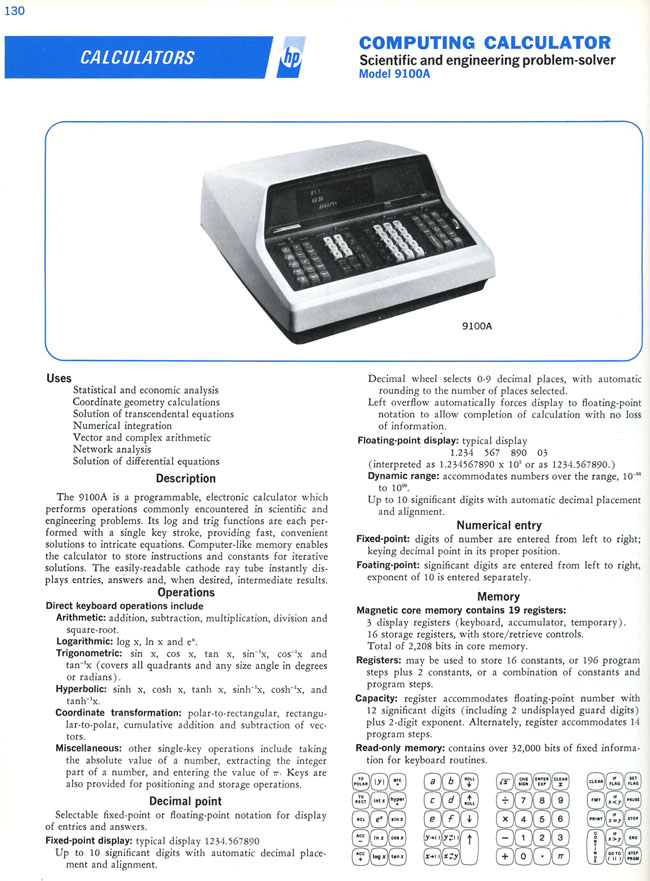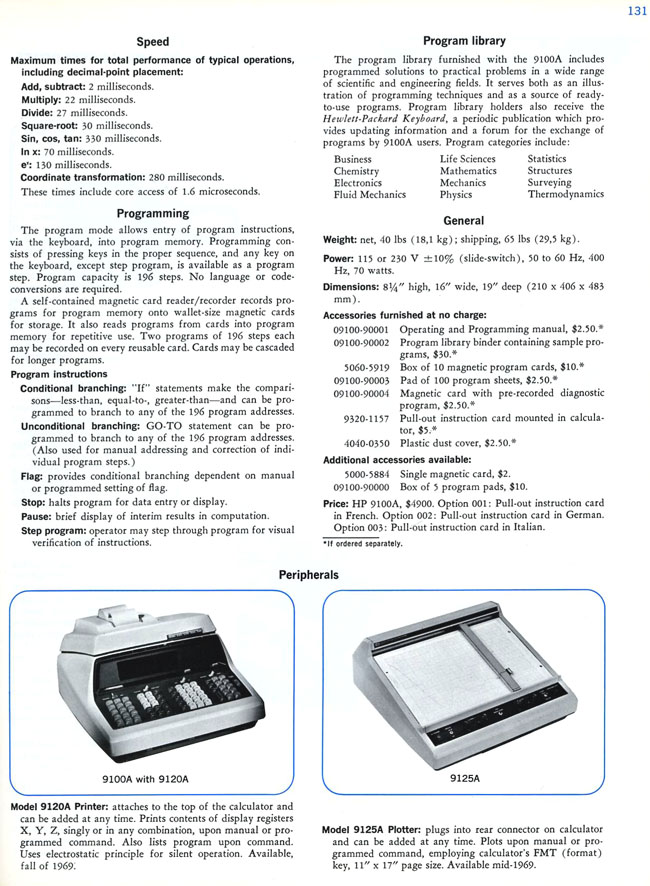

 |
The HP 9100B Calculator |
The model 9100A is introduced in the September, 1968, Hewlett-Packard Journal and appears for the first time in the 1969 catalog, page 130 with the following description:
The 9100A is a programmable, electronic calculator which performs operations commonly encountered in scientific and engineering problems. Its log and trig functions are each performed with a single key stroke, providing fast, convenient solutions to intricate equations. Computer-like memory enables the calculator to store instructions and constants for iterative solutions. The easily-readable cathode ray tube instantly displays entries, answers and, when desired, intermediate results.
Direct keyboard operations include: Arithmetic, Logarithmic, Trigonometric, Hyperbolic and Coordinate transformation. Decimal point is selectable, fixed or floating-point notation for display of entries or answers. A decimal wheel selects 0-9 decimal places, with automatic rounding to the number of places selected.
Magnetic core memory contains 19 registers: 3 displays registers (keyboard, accumulator, temporary) and 16 storage registers, with store/retrieve controls. These registers may be used to store 16 constants, or 196 program steps plus 2 constants, or a combination of constants and program steps. The read-only memory contains over 32,000 bits of fixed information for keyboard routines.
Programming: The program mode allows entry of program instructions, via the keyboard, into program memory. Programming consists of pressing keys in the proper sequence, and any key on the keyboard is available as a program step. Program capacity is 196 steps. No language or code-conversions are required. A self-contained magnetic card reader/recorder records programs for program memory onto wallet-size magnetic cards for storage. It also reads programs from cards into program memory for repetitive use. Two programs of 196 steps each may be recorded on every reusable card. Cards may cascaded for longer programs.
Speed: Maximum times for total performance of typical operations, including decimal-point placement:
Add, substract: 2 milliseconds. Multiply: 22 milliseconds. Divide: 27 milliseconds. Square-root: 30 milliseconds.
Sin, cos, tan: 330 milliseconds. ln x: 130 milliseconds. Coordinate transformation: 280 milliseconds.
It is interesting to note that computer performance of this size was state-of-the-art just one year before the first moon landing.
Price: $4900. (Average cost of a new car in the USA in 1968 was $2800)
The model 9100A is made of discrete components only. It does not contain integrated circuits, except for a couple of operational amplifiers in the card reader board. The storage capacity (Read Only Memory) required by the HP 9100 design is about 1000 times beyond the abilities of the primitive integrated circuits available at the time. The ROM used must have 64 outputs and must store 32,768 bits. It is made of a large, complex, 16-layer, Teflon printed circuit board and 2400 discrete diodes.
Program and variable storage-space requirements are also beyond the then state-of-the-art integrated circuits so the HP 9100A uses magnetic core memory popular in mainframe and minicomputers of the 1960s.
The display consists of a CRT with oscilloscope-like internal adjustment of brightness, focus and astigmatism. The numbers are formed from an 8 segment format just like the LED displays that will come later. The entire three level stack is displayed on three lines.
| Inside View of the 9100B Calculator |
 |
 |
The HP 9100B Calculator with 9120A Printer |
The HP 9100A was introduced first in 1968 with maximums of 16 storage registers and 196 program steps.
The HP 9100B, in 1970 doubles this capacity with maximums of 32 storage registers and 392 program steps. On both machines, core was shared between registers and program steps. (The 9100B had two pages of core.) The HP 9100B also added subroutines, a dual program display, and a key to recall numbered registers into X.
The HP 9101A Extended Memory, is introduced in the 1971 catalog supplement. It is a rack mountable box of core memory providing an additional 3472 program steps or 248 data registers. This option could be added to either model.
The Model 9120A Printer, shown on the above photo, attaches to the top of the calculator. It is introduced in late 1969 for use with the 9100A and remains compatible with the 9100B version. The 9120A, electrostatic printer, prints the contents of display registers X, Y, Z, singly or in any combination, upon manual or programmed command.
| Page 130 of the 1969 Catalog |
 |
| Page 131 of the 1969 Catalog |
 |